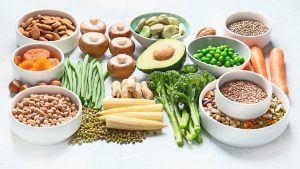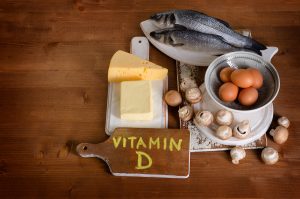An article in Nature Communication essentially asks what makes us sick and what keeps us healthy? The publication is about eating enough flavonoids to protect you from heart attacks and cancer.
The publication appeared on Aug. 13, 2019. It is a prospective study involving 56,048 participants of the Danish Diet, Cancer, and Health cohort. The medium age of the participant in the beginning of the study was 56 (range 52 to 60). This was cross-linked with Danish nationwide registries. The observation time was 23 years during which 14,083 participants died. As this study had a high number of participants and had a long observation period, the data are quite robust.
The researchers found that when people consume 500 mg of flavonoids from vegetables and fruit per day, they are dying significantly less from heart attacks and cancers.
Details of the study on flavonoid intake
Flavonoids are polyphenolic compounds in plant-derived foods and beverages such as vegetables, fruit, dark chocolate, coffee, tea, and red wine. There are six major subcategories of flavonoids: flavonols, flavan-3-ols, flavanones, flavones, isoflavones and anthocyanins. But it does not matter, which ones we consume, just that we consume enough (more than 500 mg per day).
The results were obtained with much stratification. For instance, in one set of results they normalized for age and sex. They called this model1. In another set they adjusted for age, sex, BMI, smoking status, physical activity, alcohol intake, hypertension, hypercholesterolemia, social economic status (income), diabetes, and prevalent disease. They called this model 2.
Participants with 536 mg of daily flavonoid intake had a reduction of 39% of heart attacks according to model 1. Using model 2 this changed to a reduction of 18% of heart attacks.
Cancer mortality reduction
The investigators did a similar analysis for cancer mortality reductions. At 536 mg of daily flavonoid intake model 1 showed a 36% reduction of cancer mortality. Model 2 still calculated a 21% reduction of cancer mortality. In both cases, the cardiovascular mortality risk and the cancer risk showed that more than 500 mg of flavonoids per day were not necessary as no more lives were saved by increasing the flavonoid dose beyond that. Unfortunately the opposite is true: people eat too many processed foods devoid of flavonoids, and they die of heart attacks and cancer prematurely.
Reducing the risk of heart attacks and cancer is not new
Many studies have shown what researchers found in this study, namely that vegetables and fruit can prevent heart attacks and cancer. Here is a brief summary with links to show this.
We heard many times that small amounts of alcohol consumption will keep the arteries clear of fatty deposits. This prevents heart attacks and strokes, but as the following study shows even small amounts of alcohol can cause various cancers.
Small doses of alcohol are still cancer producing
Dr. Timothy S. Naimi from Boston University Medical Center was the main investigator of an international team of scientists. The study found that every year 18,200 to 21,300 cancer deaths in the US (that is 3.2% to 3.7% of all US cancer deaths) are due to alcohol consumption. The authors of the study determined that every person who dies from alcohol related causes lost on average approximately 18 years of his/her life (scientists call this “years of potential life lost”). 51% of women developed breast cancer from alcohol exposure, 62% of men came down with upper airway and esophageal cancers. Less than 1.5 drinks per day caused between 26% and 35% of alcohol-related cancer deaths. There was no safe lower margin. The authors concluded, “Reducing alcohol consumption is an important and underemphasized cancer prevention strategy”.
Lifestyle important for longer life expectancy
I am reminded of a talk that Dr. David Katz delivered in a keynote address. He said that lifestyle improvements create profound changes in our system. This talk took place at the 22nd Annual World Congress on Anti-Aging Medicine in Las Vegas Dec. 10-14, 2014. One study that was mentioned showed that in men who adopted a healthy lifestyle 35% of heart attacks could be prevented. With healthy lifestyle the authors meant consuming a healthy diet, not exceeding moderate alcohol consumption, no smoking, regular physical activity and having a normal waist circumference (less than 95 cm).
The ingredients you need to make it to age 100
A Swedish longevity study that went on for 50 years gave me the idea to write a blog about the factors that can help you to turn 100 and still have your mental capacity and good health.Let me introduce you to this study. Researchers at the Sahlgrenska Academy in Göteborg, Sweden (which is located at the University of Gothenburg) decided back in 1963 to follow a group of 855 Gothenburg men born in 1913 until they would either die or turn 100. The idea was to find out what killer diseases are in the way to reach such a ripe old age and if they would survive, what was it that made them reach this age. Think of it as a race to turn 100.
What diseases killed at older age and what led to longevity?
The researchers had checkpoints along that journey: various surveys were conducted at the age of 54, 60, 65, 75, 80 and 100 to analyze the factors that lead to longevity. 27% (232) of the original group reached the age of 80, and 13% (111) made it to 90. Only 1.1% of the men made it to the age of 100. What were the causes of death for the other ones who did not make it? 42% of deaths after the age of 80 were due to heart attacks, 20% due to infectious diseases, 8% due to strokes, 8% due to cancer, 6% due to pneumonia and 16% due to other causes. 23% of the men over 80 were diagnosed with Alzheimer’s or dementia. Factors that made people survive were refraining from smoking, maintaining a healthy cholesterol level and limiting coffee consumption to not more than 4 cups per day.
Beneficial effects of green tea and black tea
A meta-analysis involving 194,965 people and 4378 strokes found that there was a reduction of strokes with increasing tea consumption. Those who drank 3 or 4 cups of green tea or black tea per day were the experimental group. Researchers compared them to the control group that drank less than one cup of tea per day. The experimental group had a 21% lower risk of getting a stroke than the control group.
A meta-analysis of 18 studies from China showed that green tea and black tea consumption was beneficial for prevention of cardiovascular disease and for cancer prevention. The highest consumption of green tea reduced cardiovascular mortality (heart attacks and strokes) by 33%. The highest black tea consumption lowered mortality by 12%. Cancer mortality turned out different. Green tea did not produce a reduction in mortality, but black tea lowered it by 21%. I suspect that the different subcomponents of the bioflavonoid content in green and black tea are key to those findings.
Plant-based diet versus animal protein based diet
A 2016 study that had gone on for 49 years was involving 131,342 participants. Animal protein intake showed an association with higher mortality from heart attacks and strokes. The investigators substituted 3% of energy from processed red meat by an equivalent amount of plant protein. This reduced the all-cause mortality by 34%. For unprocessed red meat the 3% substitution reduced the all-cause mortality by 12%. If 3% of egg consumption is reduced, all cause mortality drops by 19%.
British Medical Journal study
A new study has shown that you can save lives when you replace red meat and processed red meat. The replacement was with fish, poultry or protein from vegetables. The study appeared in the British Medical Journal on June 12, 2019. It involved 53,553 women nurses and 27,916 male doctors in the United States and ran from 1986 to 2010. Here is my summary of the blog where I reviewed this study in detail. A new study in the British Medical Journal showed that an increase in red meat consumption of only ½ serving per day for 8 years caused an increased mortality of 9% over the following 8 years. With regard to processed red meat the mortality was even bigger, namely 13%. The researchers replaced some of the meat with white chicken meat or vegetables and the mortality normalized.
In contrast, a Japanese study showed that there was no increase in cardiovascular disease with the consumption of up to 100 grams of beef or other meat products per week. The study went on for 16 years.
Using antibiotics as growth promoters is illegal in Japan and Europe
I pointed out before that there is literature explaining why there is a discrepancy: the beef industry in the US feeds the animals antibiotics as growth promoters. This changes the bowel flora in humans who eat the beef. The changed bacterial strains in the gut use carnitine from beef and make trimethylamine N-oxide (TMAO). This is a toxin that causes both cardiovascular disease and cancer. This explains why in the US beef is one of the culprits that cause heart attacks and colorectal cancer. In Japan this is not the case. Both Japan and Europe do not use antibiotics as growth promoters in the cattle industry, as it is illegal.
In the US it is likely safe to eat organic meats (beef, chicken) as these meats will not contain antibiotics. Due to the numerous additives in processed red meat, it is a sensible idea to skip these products altogether, as they produce cancer.
Conclusion
Several studies have pointed out the importance of eating less animal protein and increasing vegetables and fruit in your diet. Heart attacks, strokes and cancers are still the major causes of death in all of the developed countries. The Danish study mentioned in the beginning showed that keeping the daily intake of bioflavonoids at 500 mg or more prevented 18% to 39% of heart attack mortality and 21% to 36% of cancer mortality.
In other studies we learnt that deaths between the ages of 80 and 100 were mainly due to heart attacks, strokes and cancer (these accounted for 58% of deaths). Only 1.1% of the men in that Swedish study made it to the age of 100.
More evidence that flavonoids and plant protein save lives
Another study measured the effect of green and black tea consumption: There was a 21% reduction of strokes with green or black tea consumption.
Another study found reduced cardiovascular mortality by 33%. Green tea reduced cancer mortality by 21%.
Another study showed that when plant protein replaced red meat there was an astounding drop of the all-cause mortality by 34%.
All of these studies show that you must eat enough flavonoids to protect yourself from heart attacks and cancer. Of course you also need to engage in a regular physical exercise program to stay fit and healthy.







